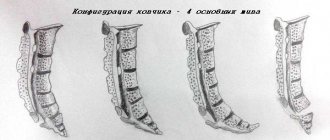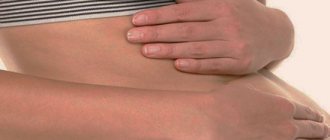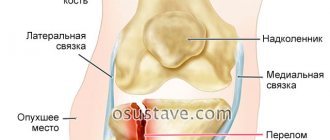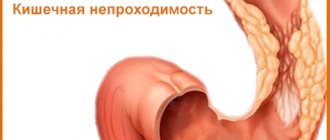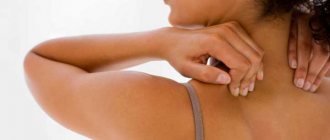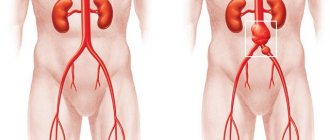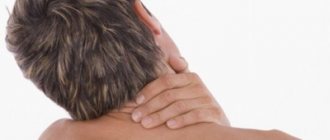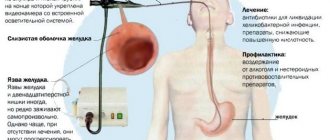Causes
Head pain is associated with:
- Diseases of the ENT organs, in which the paranasal sinuses become inflamed. This group of deviations includes frontal sinusitis and sinusitis. They cause swelling of the mucous membrane of the nasopharynx, so breathing worsens, the supply of oxygen to the brain is disrupted, and cephalgia occurs. Additionally, the patient experiences nasal congestion, impaired sense of smell, and severe pain in the eyes.
- Poisoning. Intoxication through contact with chemicals, drug overdose, consumption of low-quality products or alcohol causes persistent cephalalgia in the forehead area.
- Cervical osteochondrosis. Compression of the vertebral arteries causes disruption of blood flow in the vessels of the brain. This causes oxygen deficiency and severe pain in the forehead.
- Traumatic defeat. The symptom occurs when the front of the head is damaged. Additionally, nausea and vomiting and dizziness occur.
- Decrease or increase in pressure. In the first case, the pain is of a compressive nature, in the second - bursting.
- The development of a malignant neoplasm in the frontal lobe. Oncological disease manifests itself in emotional instability, seizures, hearing and vision impairment.
- Migraine. Cephalgia is pulsating and severe. A person who suffers from migraine attacks has an intolerance to light and sound.
Less dangerous reasons that cause headaches: overwork, emotional stress, lack of sleep.
What to do for a headache in the forehead?
The answer to this question is obvious - look for the cause of the pain and get treatment. To help a doctor make a diagnosis, you need to listen to your body and accurately describe the nature, frequency, exact location of pain and factors. which provoke its appearance. The earlier a disease is detected, the faster you can get rid of it, and in some cases, prevent life-threatening conditions.
Treatment options for headaches vary widely and may include:
- drug treatment;
- lifestyle changes (full rest, normalization of sleep, elimination of stress factors);
- acupressure (can be performed either independently or with the help of a specialist);
- acupuncture.
For brain tumors, surgery may be prescribed.
How to reduce pain without pills
First of all, it is necessary to eliminate the factors that provoke headaches. In some cases, it is enough to lie down in silence for a while, dim the lights and drink herbal tea with honey. Sometimes sleep, even a short one, can help relieve pain.
If you have a headache in the forehead and put pressure on your eyes, you should reduce your visual load as much as possible, check your vision and change your glasses or contact lenses (if your vision has deteriorated).
Acupressure has a good effect on headaches in the forehead. The most effective points are at the base of the skull (in the center and on the sides on the inside of the large vertical muscles of the neck) and on the bridge of the nose (in the depression between the eyebrows). You can enhance the effect of a massage with the help of essential oils, the only thing is that you should be careful with oils for migraines, since the intense smell can only worsen the condition.
“Tension headaches” require changes in your usual lifestyle. This may require changing jobs, educational institutions, or reducing the extracurricular workload for the child or teenager. You will also have to significantly reduce the time spent watching TV and the computer, especially before bed. Very often, headaches are provoked by excessive fascination with gadgets - because of small screens, vision is especially strained.
Walking in the fresh air, massage of the cervical-collar area, and spa treatment are very useful for headaches of various etiologies.
How to get rid of a headache in the forehead?
The very first thing that comes to mind when dealing with this problem is to take a pill; fortunately, the choice of painkillers, which are also sold without a prescription, is extremely wide. However, you should not self-medicate; it is much more effective to go to see a doctor, find out the cause of the pain and get prescriptions taking into account all the characteristics of your body.
You should know that painkillers are far from harmless and have an impressive list of side effects. Even the familiar paracetamol has an adverse effect on the liver, and other non-steroidal anti-inflammatory drugs deprive the natural protection of the mucous membrane of the stomach and duodenum, which leads to gastroduodenitis and ulcerative lesions.
The main groups of drugs that are used if you have a headache in the forehead, temples, eyes and back of the head:
- non-steroidal anti-inflammatory drugs (NSAIDs) - cope well with “tension headaches” and episodic pain;
- drugs from the triptan group are effective in the treatment of migraines;
- analgesics and antispasmodics - used for influenza and ARVI, mild forms of migraine;
- anticonvulsants - used for trigeminal neuralgia and migraines.
If you have a headache in the forehead and feel nauseous, you can take an antiemetic. To avoid harming yourself, you should make sure that nausea is not caused by poisoning.
Headache prevention
In order to minimize the frequency of headache attacks, a number of recommendations should be followed:
- ensure proper rest and sleep;
- plan your working time so that there are no overloads;
- reduce the time you use gadgets and spend time at the computer
- avoid eye strain;
- exclude from the diet foods that provoke headache attacks (alcoholic drinks, coffee, cheese, chocolate).
If your head hurts in the forehead area constantly or the pain is very intense, you should immediately consult a doctor and follow all his instructions.
What to do and how to treat
Regular headaches require seeing a doctor.
Patients who complain of cephalalgia covering the forehead area are prescribed the following diagnostic measures:
- Blood and urine tests;
- Dopplerography;
- Electroencephalography;
- MRI;
- Angiography;
- Sampling and examination of cerebrospinal fluid.
The course of treatment depends on the results of the examination.
To find out what to do during an attack of pain, you need to consult a doctor. Patients are often advised to take a pain reliever (Ibuprofen, Paracetamol, Acetylsalicylic acid).
You can take a drink made from 20 g of cinnamon, poured with 100 ml of hot water. You need to drink it cooled, adding a little sugar, a few sips per hour.
Deterioration of condition and associated symptoms
Relatively harmless sensations of discomfort, pulsation, shooting or pain may also appear in the forehead and temples, which are a signal of immediate danger that may herald the onset of a serious condition.
When they are accompanied by additional threatening symptoms, you can no longer hesitate to consult a doctor. In different cases, the temples and forehead, with pain of a different nature, are accompanied by:
- fever, dizziness, vomiting and nausea (meningitis, encephalitis, brain abscess, hypertensive crisis;
- loss of speech ability and understanding of others - very possibly a stroke;
- blurred vision, blurred vision, pain when pressed - temporal arteritis, which can cause blindness, stroke, and impair blood circulation in the brain;
- pain accompanied by nausea, vomiting, loss of consciousness - poisoning with poison or toxic components, drugs.
When the pain in the temples and forehead is uncharacteristic, with the manifestation of additional complications, for several days or with breaks per day, or several hours, immediate consultation with a doctor is necessary.
In such cases, harmless reasons are unlikely to operate.
The reason for medical diagnosis is considered to be increased pain when coughing and sneezing, the inability to relieve pain with medications, a persistent symptom during sleep, and an increasing nature of pain.
Constant pain in the forehead and temple, and radiating to the eye or ear - an inflammatory process in the organs of vision or hearing - the causes must be immediately eliminated before they develop into something more.
Daily frontal pain
If the forehead area hurts every day, then this is due to:
- Chronic fatigue;
- Ophthalmic diseases (for example, glaucoma);
- Brain tumors;
- Untreated viral infections.
Regular attacks of cephalalgia occur in those who do not follow a balanced diet and consume a lot of unhealthy foods.
These include:
- Chocolate and coffee, large doses of which cause pressure surges;
- Salty foods and smoked foods that affect blood pressure levels;
- Citrus fruits, eggs, red wine, which cause allergic reactions.
To determine the cause of pain in the frontal lobe, contact a neurologist, otolaryngologist, ophthalmologist and other specialized specialists.
How to get rid of pain?
If the cause of frontal pain is a disease, then treatment tactics are usually aimed at relieving symptoms.
- Painkillers are prescribed: analgesics, non-steroidal anti-inflammatory drugs, and for migraines - special anti-migraine drugs.
- If the patient's temperature rises above 38.5 degrees, he should take antipyretics.
- When pain occurs due to an inflammatory process caused by a bacterial infection, the doctor prescribes antibiotics.
- To reduce intracranial pressure, the patient is prescribed drugs that normalize cerebral circulation.
- Meningitis, malignant tumors, and nerve damage should be treated in a hospital setting under the supervision of doctors.
Since pain in the frontal part of the head can occur for various reasons, do not delay visiting a doctor who will make an accurate diagnosis and prescribe treatment.
Which doctor should I contact?
Often, after physical exertion or mental stress, people feel worse. The nature of the pain can be varied. Compressive, pressing, throbbing pain in one side of the head is possible.
Pain during exercise is often functional in nature. They can occur for many reasons:
- Changes in temperature and atmospheric pressure;
- Stressful state during physical activity;
- Heat and stuffiness in the room;
- Dehydration is often the cause of headaches;
- Eat a large meal before training;
- Overweight people often suffer from hypoxia during exercise.
The likelihood of illness is higher in people with specialties: programmer, accountant, driver, who spend many hours at the computer or constantly strain the muscles of the eyes and neck.
Persistent cephalgia, which occurs regularly, requires mandatory consultation with a doctor in order to exclude serious pathology and prescribe the correct treatment in a timely manner.
The initial appointment should be made by a therapist. He will conduct a general examination, measure blood pressure, write out directions for tests and refer you to specialists.
If you have unpleasant sensations in the head and neck area, it is good to have a home blood pressure monitor, with which you can track pressure surges in different life situations. A rise in blood pressure after physical activity can often be the cause of pain.
The doctor gives a referral to an otolaryngologist to rule out chronic otitis media, sinusitis or inflammation of the maxillary sinuses (sinusitis).
The doctor can give a referral to an ophthalmologist to identify changes in the fundus and possible vision defects.
Most of the causes of discomfort in the head are associated with neurological symptoms, so diseases accompanied by head pain syndrome are treated by a neurologist.
Treatment
The purpose of therapy depends on why the headache in the forehead area hurts. Doctors do not recommend self-medication, since the patient often does not know the real cause. Unpleasant sensations in the forehead are not a disease, but only one of the manifestations.
Self-treatment consists of taking painkillers that will eliminate pain and help you forget about the problem. But, as a rule, this helps for a short time or does not help at all. Temporarily eliminating pain does not solve the problem. In addition, these drugs have many side effects that affect other human organs. Systematic use of painkillers will lead to improper functioning of the liver and disrupt the intestinal mucosa.
Treatment of headaches involves a comprehensive approach, which includes taking a number of medications. But drug therapy does not solve everything. And in addition to it, doctors recommend acupuncture and acupressure. But an important part of any therapy is changing the rhythm of life, daily routine, and nutrition.
If a tumor is discovered in a person’s brain, treating pain with pills is useless, so surgery is prescribed.
In addition to traditional methods of treatment, folk ones are also used. But using alternative medicine on your own is not recommended. It is part of an integrated approach. But before using infusions and decoctions in treatment, you need to consult with your doctor.
Medications
After identifying the cause of the severe forehead pain, drug treatment is prescribed. It is aimed at eliminating unpleasant manifestations, muffling the pain syndrome, and also combating the root cause.
Treatment for headaches consists of a variety of medications, depending on the possible cause and associated symptoms. If inflammation is detected in the body during testing, anti-inflammatory drugs are prescribed. The most popular and effective are Paracetamol with Ibuprofen, Diclofenac. They are suitable for influenza, acute respiratory viral infections and acute respiratory infections to relieve fever and eliminate pain.
Aching, squeezing, throbbing and other pains are eliminated with the help of antispasmodics. Popular are No-shpa with Papaverine. If the nature of the discomfort in the forehead and back of the head and other parts of the head is infection, a specialist will prescribe antibiotics. These can be topical medications in the form of nasal drops, as well as in the form of tablets and injections. Polydexa with Isofra and Cephalosporin - drops to eliminate infection in the nasopharynx, which is the cause of compression in the forehead.
The root cause of influenza is a virus that affects the entire body. The solution to the problem is antiviral drugs like Aflubin and Amizon. If swelling is detected, a specialist will prescribe antihistamines - Suprastin with Zyrtec. They are aimed at relieving swelling that has arisen on the mucous tissue.
Eye diseases often cause pain in the forehead. Therapy for these diseases consists of using eye drops - Fotil and Xalacom. These drugs are prescribed for increased pressure in the eyes. High blood pressure is reduced with Cartopril and Enalapril.
In addition to the above, sedatives are also prescribed. A severe headache makes a person restless and irritable and interferes with sleep. Novo-passit with Persen are common sedatives that are taken for neuroses.
Folk remedies
Traditional medicine methods should not be used as an alternative to traditional medicine. The best option is to supplement drug therapy with them, in order to avoid constant use of painkillers. The advantage of folk remedies is their safety. This allows them to be used not only by adults, but also by children.
The most common option is compresses. This option is suitable for high blood pressure. For a compress on the forehead and back of the head, use a solution of vinegar and water. For 200 ml of liquid there are 15 ml of acetic acid. Dip a small piece of cloth into the solution, wring it out and apply it to the sore spot. When dry, moisten again and repeat until the pain goes away.
Another compress, which is used to eliminate unpleasant symptoms in the head, requires cosmetic clay and essential oil. Mix clay with water in an approximate proportion of 1 to 3 so that the consistency resembles liquid sour cream. The required amount of clay is approximately 150 grams. Add a few drops of lavender or mint essential oil to the resulting mixture. Place the mixture between layers of cloth or gauze, place it on the forehead, temples, and leave for at least 20 minutes.
Sharp, throbbing pain in the forehead can be eliminated with the help of garlic and its juice. They can be used to lubricate the bridge of the nose, forehead and temples.
Chamomile is an anti-inflammatory and sedative in folk medicine. Dried inflorescences in the amount of 5 grams, add water and keep on fire for at least five minutes. After this, leave and cool the broth, strain and drink before eating. For one dose, 70 ml is enough.
St. John's wort has a sedative effect. To make tea from it you need a spoonful of dried herbs and a glass of boiling water. You need to insist for 30 minutes, and after this time you can take it. Divide the resulting liquid into 3 doses.
If you have a headache in the forehead or back of the head, it is useful to drink fresh carrot juice. It helps not only with unpleasant sensations in the head, but is also good for vision. A glass of juice a day is enough to feel better.
What tests are usually prescribed?
At an appointment with a neurologist, a physical examination of the patient is performed: basic neurological reflexes are checked and the neck muscles are examined.
The doctor writes out a referral for tests: general blood test, biochemical blood test, blood sugar test.
A general blood test with an increase in ESR or an increased content of leukocytes indicates inflammation in the body.
Blood biochemistry may indicate a deficiency of one of the vital elements, which leads to discomfort in the head area.
Low blood glucose levels are often accompanied by cephalgia, dizziness and weakness.
The doctor may write a referral for additional tests:
- The gas composition of arterial blood can reveal cerebral hypoxia.
- A blood test for hormones determines various abnormalities in the functioning of the hypothalamus.
A neurologist can give a referral to one or more diagnostic methods:
- Magnetic resonance imaging (MRI) - excludes the presence of various neoplasms (tumors and cysts), aneurysms. The photographs clearly show post-traumatic defects, neurodegenerative abnormalities, and changes in blood vessels affected by atherosclerosis.
- Computed tomography (CT) is the most informative method for studying the brain. It gives a clear idea of pathological changes in the skull and brain, pathology of bone tissue, blood vessels and brain structures. Provides information about the consequences of traumatic brain injuries. The disadvantage of this method is the significant radiation dose during the study.
- Electroencephalography gives an idea of the presence of pathological changes in blood vessels and impaired cerebral circulation.
- Doppler ultrasound (ultrasound of the vessels of the head and neck) - shows the presence of atherosclerotic plaques in the arteries; narrowing and tortuosity of the arteries, leading to brain hypoxia; peripheral vascular resistance.
- Rheoencephalography (REG) - gives an idea of the tone and blood flow of blood vessels. Using REG, the following are diagnosed: hypertension, atherosclerosis, vegetative-vascular dystonia.
- MRI of the cervical spine - the presence of cervical osteochondrosis can cause pain in the head and neck, which intensifies when turning the head.
- Rheovasography of cerebral vessels (RVG) - shows the quality of blood flow through the great vessels, evaluates collateral circulation.
- Radiography will be less known. In the image you can only see the bone structures of the skull, soft tissues are not visible.
There is no need to panic when scheduling such a serious examination. The doctor excludes rare severe pathologies and looks for the causes of the pain process.
Based on the studies, if no serious organic lesions are found, the cause of the disease is usually diagnosed. It develops as a result of: vascular spasms, cerebral hypoxia, hypertonicity of cerebral vessels, hormonal imbalances, vegetative-vascular dystonia or osteochondrosis, provoked by physical or psycho-emotional stress.
Secondary provocateurs of symptomatic tandem
The head can also hurt from secondary provocateurs, which are also conventionally divided into several large groups.
Pain can appear from poisoning the body with salts of heavy metals, ethyl alcohol, carbon monoxide.
This can be caused by pesticides and even medications, manifesting itself as a hangover syndrome in alcoholics, or as a withdrawal syndrome in drug addicts.
Negative sensations may appear in the forehead and temples as a result of an unhealthy diet.
The temples and forehead are also under attack from eating harmful foods, food containing substances harmful to humans.
The causes of headaches are the effects of toxic components on the brain.
Poisoning can always be accompanied by nausea, and it appears in the temples even with a sore throat, hangover and eating disorders.
The causes of pain may lie in vascular pathologies. Any disease that interferes with normal blood circulation can increase or decrease blood pressure.
Vascular pathologies also include atherosclerosis of the cerebral arteries; it can give sensations that are not acute, but constant, due to a disruption in the supply of necessary oxygen to the brain.
The pressure in this disease is usually high, because the lumen of the vessel is closed by deposits of cholesterol and lipids, and pain becomes an indispensable companion for a person with impaired blood flow.
Traumatic brain injury can often have consequences in the form of pain for many years, occurring constantly in the area that was hit or bruised
In this case, the localization of phantom sensations and the nature of the pain depend on how severe the damage was and what part of the forehead or head it was in.
Thermal effects, cold or excess heat, are sometimes localized in the frontal lobes.
It usually hurts from overheating, but cold can also lead to inflammatory processes in the brain nerves, causing pain due to the inclusion of compensatory mechanisms, narrowing or dilation of blood vessels that occur during cold and heat.
The causes of the symptom may also lie in metabolic disorders.
Lack of glucose in the blood (hypoglycemia) can cause headaches due to a lack of normal brain function, while lack of oxygen (hypoxia) can depress the central nervous system, causing an increase in breathing rate and headaches.
The opposite phenomenon with hypoxia is hypercapnia - an excess of carbon dioxide in the blood.
In both cases, the head hurts due to improper metabolism and pathological supply of nerve cells, which are very sensitive to such pathologies.
Some disturbances in the activity of the endocrine glands can lead to headaches not only in the forehead and temples, but also diffuse or diffuse ones, which can be accompanied by mental retardation and gradually progressing visual and genital disorders.
In the area of the skull they are accompanied by the growth of the frontal plate, the growth of bones or their thickening.
The forehead and temples, according to some estimates, can affect up to 50 pathologies associated with various diseases, and pain of such dislocation, in these conditions, is just a symptom that is difficult to focus on.
Eye diseases, spinal pathologies, nervous system diseases, and tumors also lead to headaches.
The reasons may lie in abnormal growths, metabolic disorders, external influences, and impaired blood flow.
The head in the forehead area suffers from pathologies of the nervous system, vascular anomalies, neoplasms, and migraines.
This is a very broad topic that will require several volumes of scientific research.
The causes of pain can be vascular, muscular, neuralgic, liquorodynamic, central and mixed causes.
Safe medications and pills
When planning a visit to the doctor, the patient should be prepared to answer questions about how often pain occurs and what its intensity is. This will help the doctor develop the correct treatment tactics.
Groups of drugs effective for episodic attacks of pain
Medicines to treat this pathology are non-steroidal anti-inflammatory drugs (NSAIDs). They have an analgesic effect, relieve inflammation, and eliminate swelling.
Often prescribed:
- Ibuprofen-400 mg per day;
- Ketoprofen-100 mg/s;
- Naproxen-500 mg/s;
- Meloxicam-7.5-15 mg/s;
- Celecoxib-200 mg/s.
Most NSAIDs have a negative side effect: with long-term use, they negatively affect the organs of the gastrointestinal tract, including the development of drug-induced gastritis.
Medicines Meloxicam and Celecoxib are new generation drugs that do not have a negative effect on the gastrointestinal tract. The disadvantages of using these drugs include the relatively high price.
Analgesics are often used at home to relieve an attack. They do not treat the disease, but only relieve pain. Drugs in this group are suitable for stopping episodic attacks, but their systematic use leads to the occurrence of abuse syndrome.
During an attack of pain, you can take Paracetamol-100 mg, Citramon, Analgin-500 mg or Mig 200-400 mg.
If the examination revealed the appearance of cephalgia after exercise as a result of increased blood pressure, the doctor will prescribe medications prescribed at an early stage of the development of hypertension. These include: vasodilators, ACE inhibitors, diuretics, calcium channel blockers.
Self-prescribing antihypertensive drugs is unacceptable. Self-medication leads to serious consequences.
For muscle tension, drugs from the group of muscle relaxants are used as part of complex treatment. They relax the spasmodic muscles of the head and neck, relieving pain of a spastic nature, and help restore blood flow.
Often prescribed:
- Mydocalm-150-450 mg per day;
- Sirdalud (Tizanidine) - 4 mg/s;
- Baclofen-15 mg/s.
Nootropic drugs are often prescribed as part of complex treatment: Phenibut, Nootropil, Glycine. Nootropics have an activating effect on brain function and increase its resistance to damaging factors. The drugs improve cerebral circulation and eliminate the consequences of traumatic brain injuries.
Sedatives in combination with basic drugs lead to muscle relaxation and decreased vascular tone. Taking tranquilizers helps relieve pain, but this type of medication quickly causes drug dependence with withdrawal symptoms.
Sedatives that are not addictive: Afobazol, Atarax; alcohol tinctures of valerian, motherwort, Maryina root.
For severe attacks, a combination of drugs is used: Sirdalud 2 mg + Aspirin 500 mg or Analgin 250 mg + sedative.
The use of vitamin B complexes has proven itself. Vitamins B1, B6, B12 have a beneficial effect on the central nervous system and restore the structure of nerve tissue. Vitamin complexes are often prescribed: Neuromultivit, Milgamma, Neurovitan.
If attacks of pain recur more than 10 times a month, a course of treatment with Ibuprofen at a dose of 400 mg per day for 2-3 weeks and treatment with muscle relaxants is prescribed for 2-4 weeks.
There is no single scheme for pain relief. Depending on the cause, each patient needs an individual selection of drugs.
Treatment of chronic disease
Sometimes cephalalgia becomes chronic. The pain occurs every day, continuously, with varying degrees of intensity.
Tricyclic antidepressants are prescribed for a long course of 2-6 months. They relieve pain and help normalize the psycho-vegetative state of the nervous system.
Amitriptyline 10-100 mg/s is most often prescribed, the dose is increased gradually. The drug relieves pain well, but has many negative side effects and is addictive.
As an alternative, selective serotonin reuptake inhibitors are prescribed: Fluoxetine, Paroxetine, Sertraline. The course of treatment is at least 2 months. These drugs have less toxicity.
In addition to prescribing drug therapy, the doctor will recommend massage, a course of physiotherapy or acupuncture.
Why does my head hurt in the forehead area?
Pain in the forehead is one of the types of headaches. It occurs for numerous reasons. The nature of the pain can be throbbing, pressing, stabbing or sharp. Whether it bothers you for a short period of time or persists for a very long time. In each case, a headache in the forehead area occurs for different reasons, but there are several common ones:
- skull injuries;
- infectious and inflammatory diseases;
- pathologies of the cardiovascular system;
- diseases of the musculoskeletal system;
- pathologies of the nervous system.
In the forehead and temples area
One of the reasons why pain occurs in the forehead and temples is overexertion. Other factors that provoke irritation of pain receptors in this part of the head:
- Temporal arteritis - affects large and medium-sized arteries that supply blood to the temporal region, eyes, and optic nerves. In this case, the headache in the forehead is burning, aching, and appears suddenly.
- Increased blood pressure. Accompanied by acute, sudden pain that can even cover the back of the head.
- Trigeminal neuritis. With this pathology, the headache is severe in the frontal part only on one side, where the nerve is affected. The syndrome is paroxysmal in nature.
On right
When pain affects only one half of the frontal lobe, this also indicates certain problems in the body. This symptom may be accompanied by the following diseases:
- cervical osteochondrosis;
- damage to the mandibular joint;
- eye diseases;
- internal bleeding;
- inflammation of the frontal sinus;
- glaucoma;
- neoplasm on the right side.
Left
Unilateral pain syndrome can also occur on the left side. The reasons for this are serious pathologies from the following list:
- migraine – painfully small dots appear in the eyes, the urge to vomit is felt, photophobia is observed;
- osteochondrosis – accompanied by dizziness, pulsation of the temple;
- hypersensitivity to the weather - the entire left side of the head hurts, sensations appear before the onset of snow or rain;
- spinal injuries or head contusions - pain is felt from the affected nerves;
- infectious diseases - tooth pain, colds in the muscles of the shoulder or neck cause unpleasant painful sensations on the left side;
- tumor or metastasis of a neoplasm of another location - it often causes loss of hearing or vision.
In the center of the forehead
If you have a headache in the center of the frontal lobe, the causes may be the same pathologies as in the case when the sensations are located on the right or left. Although there are non-inflammatory factors. These include the following:
- uncomfortable pillow
- change of usual climate;
- long work at the computer;
- accumulation of monosodium glutamate, nitrates, caffeine in the body;
- drug or alcohol poisoning;
- lack of oxygen in the room.
- Laryngitis - symptoms and treatment
- Pimples on the cheeks in adolescents, men and women - causes of appearance on the skin, diagnosis, treatment and prevention
- Peeling of the scalp
Eyebrow ridges hurt
The main cause of pain in the brow ridges is frontal sinusitis. Pressing on them provokes unpleasant sensations in the eyes. Frontitis is accompanied by high temperatures up to 40 degrees. The brow ridge may even swell. Other reasons are:
- rhinitis;
- constant stress;
- chronic fatigue.
Forehead hurts and puts pressure on eyes
Unpleasant sensations can also affect the eye area. The pain syndrome appears acutely or increases gradually. The main reasons for its localization in the forehead and eyes are:
- migraine attacks - throbbing, squeezing pain, accompanied by nausea;
- stress, neuroses, overwork – lead to tension-type pain, creating the feeling of a “hoop or helmet” on the head;
- increased intracranial pressure - headache immediately after waking up, noise is felt, painkillers do not help;
- increased intraocular pressure, glaucoma - here there is acute pain in the frontal part of the head and eyes;
- false myopia – characterized by pain in the eyeballs, decreased visual acuity;
- cluster headaches - typical for men, appear at night, prevent sleep, are accompanied by lacrimation;
- Inflammatory diseases of the nasal sinuses - sinusitis, sinusitis, pain in which radiates to the area above the eyes.
Forehead pain and nausea
A person may not only have a headache in the forehead area. Sometimes some other symptoms, such as nausea, are observed. The combination of these signs may indicate the following conditions or pathologies:
- Pregnancy. Pain here is a sign of hormonal changes.
- Head injuries. After them, she hurts for a long time. Nausea and pain are accompanied by memory loss and disorientation in time and space.
- Neurological diseases. Nausea with pain is a symptom of meningitis or encephalitis, abscess of the temporal lobe. The head hurts on both sides, it feels like it is bursting.
- Increased intracranial pressure due to encephalitis, traumatic brain injury, stroke, meningitis, or brain tumor. Accompanied by severe bursting pain, often occurring in the morning.
- Food poisoning. In addition to pain and nausea, diarrhea or vomiting is observed.
- Menses. Against the background of hormonal imbalance, menstrual migraine occurs, appearing 2-10 days before the onset of bleeding.
- Climax. Against the background of nausea and pain, women note hot flashes.
Headache due to nervous pathologies
Migraine
A chronic disease accompanied by intense, periodic, throbbing pain in the forehead area covering the left or right side of the head. The onset of a migraine attack is characterized by severe throbbing pain in the temple, spreading to the forehead, eye socket and back of the head.
Migraines are usually diagnosed and treated by a neurologist.
Cluster pains
Or cluster pain in the frontal region. They are paroxysmal in nature. They appear suddenly, as if for no reason, and just go away on their own. Cluster pain can be extremely severe. Some patients have difficulty withstanding it. The pain is one-sided with short but frequent attacks (15 minutes each). Up to ten attacks can occur during the day. A neurologist treats this condition.
Mental disorders
From the nervous system, pain in the forehead area can manifest itself in mental disorders:
- hysterical neurosis,
- neurasthenia,
- suspiciousness.
Treatment methods
To combat headaches in the frontal area, first of all, treatment of the primary disease is required. To identify it, you need the help of a specialist.
- Headache due to osteochondrosis can be relieved with painkillers, dry heat, rest, massage of the cervical spine, and reflexology.
- Viral diseases require specialized treatment, after which the headache goes away.
- In case of frontal sinusitis and sinusitis, the issue is resolved by removing pus from the frontal and maxillary sinuses.
- Brain diseases require complex therapy. Their treatment is usually protracted and complex. The painful effect itself is relieved by painkillers.
- If the cause is mental in nature, then good help consists of a hot shower, a relaxing head massage, tonic teas, antidepressants, and soothing infusions. But the most effective treatment is good rest.
It is not always easy to determine why your head hurts or where your forehead is. After all, there are a huge number of reasons. Sometimes it is simply the result of overwork, but this pain can signal a serious illness. Short-term, mild and one-time pain in the forehead area should not cause concern. Good rest and a calm environment eliminate the problem. But if there is severe pain that is systematically repeated, you need the help of a neurologist.
Temporal arteritis (Horton's syndrome)
This is a chronic disease of medium and large vessels originating from the carotid artery. The disease is expressed by swelling and discomfort in the temples and temporal part. Occurs most often after 40-50 years. The main serious complication is loss of vision. This occurs due to impaired blood circulation through the vessels to the eyes and their nerves. If left untreated, the nerve tissue dies and blindness occurs. The main symptoms are headache, fever, soreness of the scalp when combing or touching with fingers. Treatment involves the administration of large dosages of glucocorticosteroids. The duration of treatment is almost a year.
Diagnostics
Diagnostic measures are determined by the localization of unpleasant sensations. For example, the forehead above the eyebrow hurts. Experts prescribe the following studies:
- radiography (excluding ENT pathologies);
- encephalography (study of the electrical activity of the brain and identification of physical and neurological damage);
- Dopplerography (study of blood flow);
- angiography (determining the condition of the blood vessels of the brain);
- MRI, CT (detection of pathological changes in brain structures);
- blood and urine tests (diagnosis of infections, inflammations, neoplasms).
What kind of pain occurs?
Episodic cyphalgia causes fewer problems, but it is better not to ignore this disorder. Symptoms appear unexpectedly, last a long time, are easily eliminated with analgesics, and are optimally suited for specialized treatment. Often such cephalalgia occurs as a reaction to changing atmospheric or blood pressure, infection, or stress. It is better to protect yourself from all provoking factors, since such manifestations of disorders can develop into a chronic form.
Frequent and severe migraines are characteristic of problems with blood vessels. It does not have any reaction to the use of painkillers, lasts several hours, and gets noticeably worse. Symptoms almost never decrease and periodically intensify.
Headache and pressure on eyes during pregnancy
If you have a headache and pressure on your eyes during pregnancy, this may indicate physical and emotional stress or the development of some disease in the body.
During pregnancy, hormonal changes occur. The body is preparing for increased stress on all organs and systems.
At this time, the risk of getting sick also increases. Most often, headaches and eye pressure in pregnant women occur due to migraine attacks. Which is associated with increased secretion of progesterone and decreased production of serotonin.
A woman's immunity is reduced during pregnancy; during this period it is easier to get sinusitis, ARVI, influenza and other infectious diseases.
If symptoms develop, you should not engage in self-therapy or use medications without a doctor’s prescription. Contact a therapist, a specialist will prescribe competent and safe treatment.
Presence of inflammatory diseases
The appearance of a persistent headache in the frontal region after a cold or viral infection is most often the result of damage to the paranasal sinuses. Such consequences result from the use of inappropriate medications or early cessation of therapy for the pathologies mentioned above. Pathogenic microorganisms penetrate the paranasal sinuses from the nasopharynx, begin to actively multiply, and trigger the inflammatory process. The disease can be acute or become chronic.
Inflammation of the frontal sinuses
Frontitis is characterized by damage to the sinuses located directly above the nose in the thickness of the frontal bone. It can be one-sided or two-sided. If left untreated, the condition may be accompanied by increased intraocular pressure. In this case, cephalalgia increases significantly and responds poorly to symptomatic therapy.
Clinical picture of frontal sinusitis:
- severe headache, concentrated in the forehead on the right or left - most pronounced in the morning, has varying degrees of intensity, intensifies as the sinus fills with mucous or purulent contents, when bending over;
- increase in body temperature - in an acute process above 38°C;
- mucous or purulent discharge from the nose, nasal congestion;
- general deterioration of health due to intoxication;
- swelling of the skin in the problem area, its redness and soreness;
- in severe cases, photophobia and loss of smell.
Frontal sinusitis is treated by an ENT specialist. Depending on the picture and complexity of the disease, the patient is prescribed antibiotics, anti-inflammatory drugs, and analgesics. Additionally, local procedures are indicated to improve the outflow of contents from the nose and disinfect the mucous membrane. In advanced situations, a puncture of the sinus is required to drain the cavity.
Sinusitis
In this case, the inflammation is localized in the sinuses located on the sides of the nose, or in one of them. Cephalgia is concentrated in the frontal part, spreading to the temples and face. It intensifies when tapping or pressing on the problem area. Feelings of bursting, aching or pressing. Accompanied by nasal discharge and nasal voice. The patient's temperature rises, loss of appetite, and general health worsens.
If the frontal part of your head hurts after a cold, it is recommended to immediately consult an ENT specialist. The specialist will conduct a diagnosis and, if sinusitis is detected, prescribe specialized therapy. Attempts to limit oneself to symptomatic treatment threaten tissue infection and the spread of the pathogen to the membranes and substance of the brain.
Ethmoiditis
The disease is characterized by damage to the ethmoid sinus, which is located deep in the skull behind the nose. It is accompanied by frontal cephalgia accompanied by fever and runny nose. The sensations occur cyclically and are accompanied by signs of general intoxication. They are worse in the morning and after a long stay in a horizontal position.
Prevention
In order to avoid headaches, it is recommended to follow certain preventive measures:
- Normalize your work and rest schedule. For an adult, sleep duration is at least 8 hours.
- Eat properly. The diet must include vegetables and fruits. They will help maintain immunity and reduce the risk of developing infectious and viral diseases.
- Avoid stress, anxiety and neuroses.
- Get rid of bad habits. These include smoking and drinking alcohol.
- Walk outdoors and exercise every day. It is important to dress appropriately for the weather conditions and not overexert yourself.
- After waking up, take a contrast shower.
Compliance with the rules of prevention will significantly reduce the risk of headaches when they are localized in the temples and forehead area.
If unpleasant sensations occur regularly, you should consult a doctor who will conduct a diagnosis, determine the cause of their occurrence and, if necessary, prescribe a course of therapy.
What to do if your eyes and head hurt
If your head and eyes hurt systematically and your unwellness lasts a long time and is accompanied by other symptoms (fever, nausea, vomiting), you should consult a therapist and ophthalmologist. Specialists will help you choose the right treatment. First of all, therapy for this condition is aimed at eliminating the cause of the symptoms. For inflammatory pathologies, the prescription of antibiotics, antiviral medications, and decongestants is indicated.
If you have a headache and pressure on your eyes due to migraine, medications from the triptan group are prescribed. High blood pressure or hypertensive crisis is treated with antihypertensive pharmacological drugs and diuretics. For injuries and concussions, neuroprotective agents are indicated. If there are hematomas or hemorrhages due to injuries, surgical intervention may be required.
- Signs of a concussion after severe, moderate and mild head injury
- Exercise headaches: causes and treatment
- Headaches when landing a plane: help during the flight
Drugs
In addition to etiotropic treatment, symptomatic therapy is carried out. Headaches are treated with analgesics, antispasmodics and nonsteroidal anti-inflammatory drugs (NSAIDs). In addition, medications are prescribed to improve blood supply and trophism of the brain. Consider the main characteristics of popular medications that are indicated for use for headaches and pressure on the eyes:
| Name of the drug | Active substance | pharmachologic effect | Indications for use | Contraindications | Side effect | Cost in rubles |
| Aspirin |
|
|
|
|
| 50 |
| Indomethacin |
|
|
|
|
| 180 |
| Sedalgin |
|
|
|
|
| 220 |
| Pentalgin |
|
|
|
|
| 270 |
| Paracetamol |
|
|
|
|
| 15 |
| Spasmalgon |
|
|
|
|
| 150 |
| No-shpa |
|
|
|
|
| 80 |
| Tempalgin |
|
|
|
|
| 250 |
| Sumatriptan |
|
|
|
|
| 130 |
| Zomig |
|
|
|
|
| 780 |
| Naramig |
|
|
|
|
| 360 |
| Imigran |
|
|
|
|
| 560 |
How to eliminate pain syndrome at home
If your forehead hurts and puts pressure on your eyes during the day, the following home remedies will help:
- Rub the temple area with Zvezdochka balm and lie down for 15-20 minutes.
- Take a warm bath with sea salt and 2-3 drops of pine or lavender essential oil.
- Take a contrast shower: alternate cool and warm water at intervals of 1 minute.
- Drink a glass of hot black tea with mint, honey and lemon.
Traditional treatment
The use of alternative medicine methods is a good addition to drug treatment. Remember that some folk remedies have contraindications for use or may have a negative effect on the effects of medications, so you should consult your doctor before using decoctions or infusions. The following folk methods will help eliminate pain in the forehead and eyes:
- St. John's wort decoction with mint. Take 2 tbsp. l. dry herb St. John's wort and 2-3 leaves of fresh mint, pour 0.5 liters of water, put on fire, bring to a boil. Then cover with a lid, leave to infuse for 30-40 minutes, strain. Take 1/3 cup 2 times a day for two weeks.
- Infusion of rose hips and hawthorn. Take 20 g of dried rose hips and hawthorn, pour 1 liter of hot boiling water. Leave to infuse for 2-3 hours. Take 0.5 cups 2 times a day after meals.
- Honey with garlic and lemon zest. Finely chop 2-3 small cloves of garlic, mix with the zest of one medium lemon and 50 g of fresh flower honey. Leave the mixture in the refrigerator for a day. Use 1 tsp. in the morning after breakfast.
- Plantain tincture. Collect 7-10 plantain leaves, wash thoroughly and chop. Pour in 50 ml of vodka and leave to steep for 5-7 days. Take 10 drops daily in the morning for a month.
BEST RECIPES FOR HEADACHES
Treatment of pathologies
What to do if a certain area of the head is bothering you? What to do if the frontal pain hurts (parts of the head cannot even be touched without causing discomfort)? Unfortunately, there is no clear answer. It is very important to establish the true cause that provoked the unpleasant sensations. In each case, only a doctor is able to select the correct treatment and prescribe the appropriate therapy.
If the painful sensation was short-term and not clearly expressed, then, most likely, there was overwork. In such cases, painkillers can relieve pain. It is worth remembering that such remedies do not cure, but only eliminate discomfort.
As for medications, the following groups of drugs are often prescribed:
- Anti-inflammatory non-steroidal drugs. These medications are: Analgin, Aspirin, Paracetamol, Ibuprofen. Drugs in this group are harmless, but have a negative effect on the gastrointestinal tract.
- Methylxanthines. These drugs include: “Theobromine”, “Guaranine”, “Caffeine-sodium benzoate”. This group stimulates brain function and improves metabolic processes in the body.
- Ergot alkaloids. Representatives of the group are medications: “Nicergoline”, “Ergotamine”, “Ergometrine”. Medicines improve cerebral blood flow.
- Myotropic antispasmodics. The safest medications that can relieve spasms and pain. These are the following drugs: “Papaverine”, “Drotaverine”, “No-shpa”, “Dumpatalin”.
- Benzodiazepines. Group of tranquilizers. These include medications: Sibazon, Midazolam, Diazepam.
- M-anticholinergics. These drugs can slow down the spread of pain. However, they have a large number of side effects. This category includes the drugs “Spazmomen”, “Platifillin”.
- Beta blockers. Medicines that relieve pain by dilating blood vessels. Representatives of the group are the following drugs: “Atenolol”, “Propranolol”, “Obzidan”, “Metaprolol”.
All patients should remember that only a doctor can determine the causes of headaches and methods of treatment. Therefore, let a specialist select the necessary drug therapy based on the examinations you have completed.
Main causes
The causes of headaches in the temples and frontal part can be a variety of pathologies. Depending on their type, a unique clinical picture will be observed. Painful sensations in the head are classified into primary and secondary.
- Primary – arise due to processes that arise in the brain. This can be caused by disturbances in the vascular network or increased tone of the head muscles. As a result, pathological processes such as migraine and cluster pain arise, characterized by their severity and strength. Localization is unilateral, usually in the temple and eye area.
- Secondary - appear after qualitative disturbances in the structures of the brain, but develop after the occurrence of pathological processes in other organs. The causes of secondary pain are infectious diseases, diseases of the ophthalmological and otorhinolaryngological (ENT) spheres.
Pathological manifestations occur in the following diseases:
- ENT diseases.
- Horton's syndrome.
- Eye pathology.
- Arterial hypertension.
- Neuralgia of the facial nerves.
- Tension headache or migraine.
- Pregnancy.



